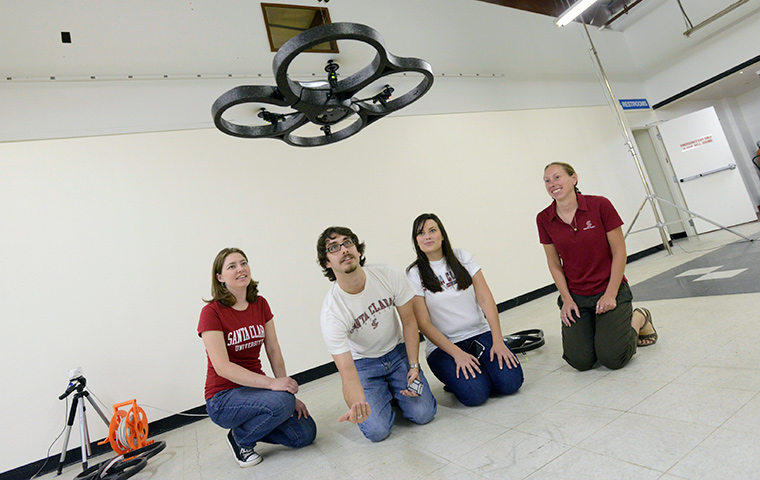
Changing the Stats
Jasmine Cashbaugh ’16 Ph.D. is working to change the stats for women in STEM with research using robots, drones, and kiwis.
The development of world-class talent in science, technology, engineering, and mathematics (STEM) is critical to America’s global leadership.
In realizing this goal, SCU heads the pack with an open and diverse scientific community that draws from an array of unique experiences and viewpoints. These include faculty mentoring of up-and- coming female engineers by passionate champions of women in STEM, such as Shoba Krishnan, associate professor of electrical engineering, who, with her own students, rigorously promotes the field of engineering to young girls.
Fortunately, gone are the days when women were socialized to avoid STEM as career choices, simply because society considered these fields to be “unfeminine.” But there is more work to be done to engage and attract females who have the curiosity, drive, and aptitude to follow their dreams of careers in STEM.
Enter Jasmine Cashbaugh ’16 Ph.D., who completed a B.S. and M.S. in aerospace engineering at Purdue University, then spent three years working as a systems engineer at Lockheed Martin Aeronautics’ Advanced Development Programs before pursuing her Ph.D. in mechanical engineering at Santa Clara University. A discussion of her research interests with a friend and SCU alumnus led to her getting in touch with his advisor and head of SCU’s Robotics Systems Lab (RSL), Prof. Chris Kitts.
According to Cashbaugh, “I chose SCU for my doctoral studies because I wanted to work on groups of unmanned aerial vehicles in a collaborative setting. I already knew the school was well regarded, and when I came to campus to meet with Prof. Kitts, the Robotics Systems Lab seemed like a good fit for me with its blend of theoretical work and hands-on experience.”
Her work as a research assistant in the RSL focused on mechatronics (the field of tech that combines electronics and mechanical engineering) and robotics, with a thesis topic of tracking a land robot using the camera data from a group of quadrotor drones flying autonomously in formation.
Understanding that Santa Clara would be a natural training ground for inspiring a new generation of engineers, the David and Lucile Packard Foundation has for years been supporting and enhancing the quality and diversity of the engineering workforce.
In 1993, the foundation established The Packard Endowed Research Fellowship Fund, a scholarship to be used for tuition, salary, and stipend for women or minority students pursuing doctoral studies in engineering at SCU.
Awarded this prestigious fellowship in 2014, Cashbaugh says, “The Packard Foundation endowment made my SCU education possible. I would not have been able to stay in the Bay Area without this tuition and stipend. It also allowed me to present my work at conferences, helping me to connect with other people in my field around the world.”
After receiving her Ph.D. from SCU, she completed a postdoctoral research fellowship at The University of Auckland in New Zealand, developing robotic pollination and harvesting of kiwifruit. “SCU helped prepare me for this trajectory with its focus on practical experience,” Cashbaugh said. “When I went out into the kiwifruit orchard for the first time, I already had experience in field testing a robotic deployment from SCU.
This was invaluable, as I was better able to plan tests and understand the results as well as solve problems that arose during testing.”
After graduating in December 2016, she headed to Seattle to focus on running JLLJ Technologies, where she serves as managing partner and is just kicking off a round of small business innovation-research proposals in the robotics field for NASA and the U.S. Department of Defense.
Casbaugh’s career goals for the next five years take an interesting—but not surprising—twist. “I ultimately want to teach, as this is where my true passion lies.” However, she adds that she plans to continue working in industry for a while to gain more experience—enabling her to join the ranks of teaching-scholar, a philosophy long embraced by SCU faculty. Cashbaugh says, “I always felt that I learned more from professors who had applied their skills in the real world and shared these insights with their students.”
Quadrotor control: Jasmine Cashbaugh (right) helps mechanical engineering students do tracking work with a quadrotor. Photo by Charles Barry